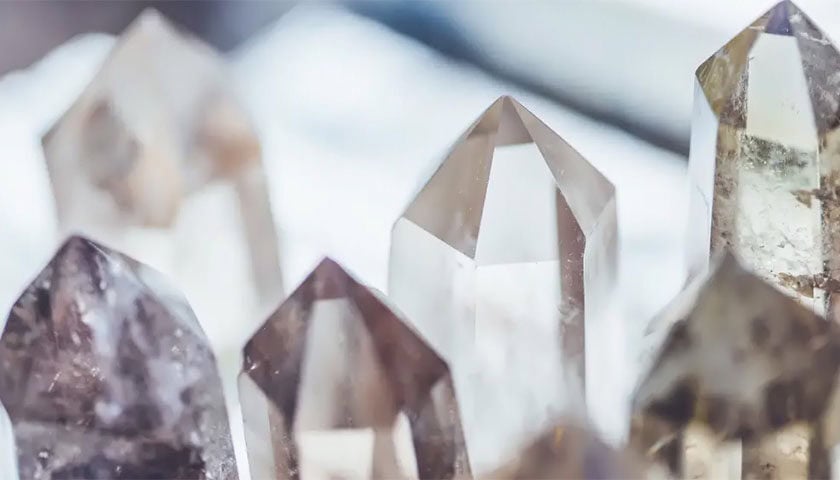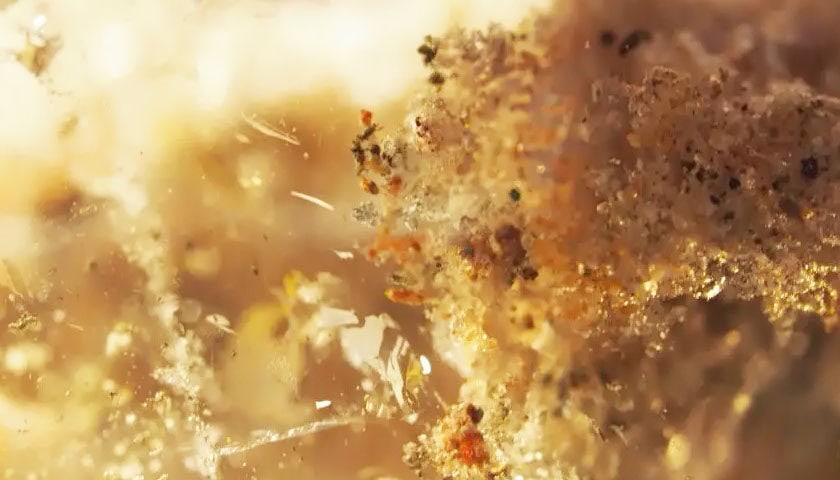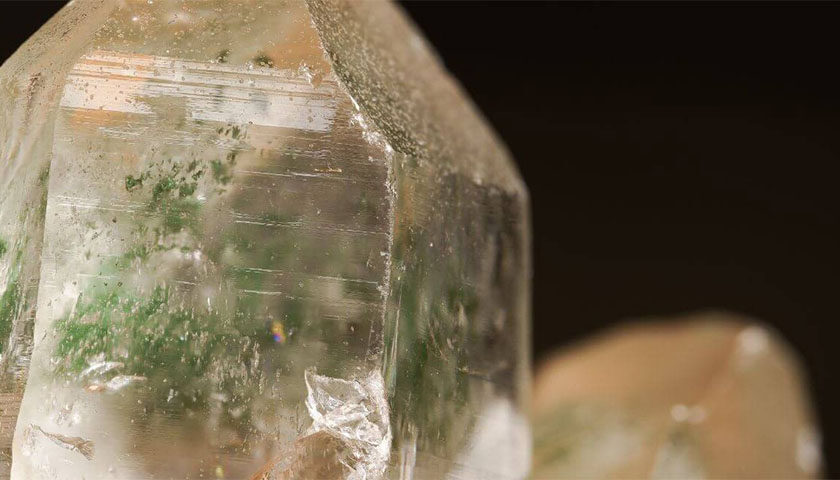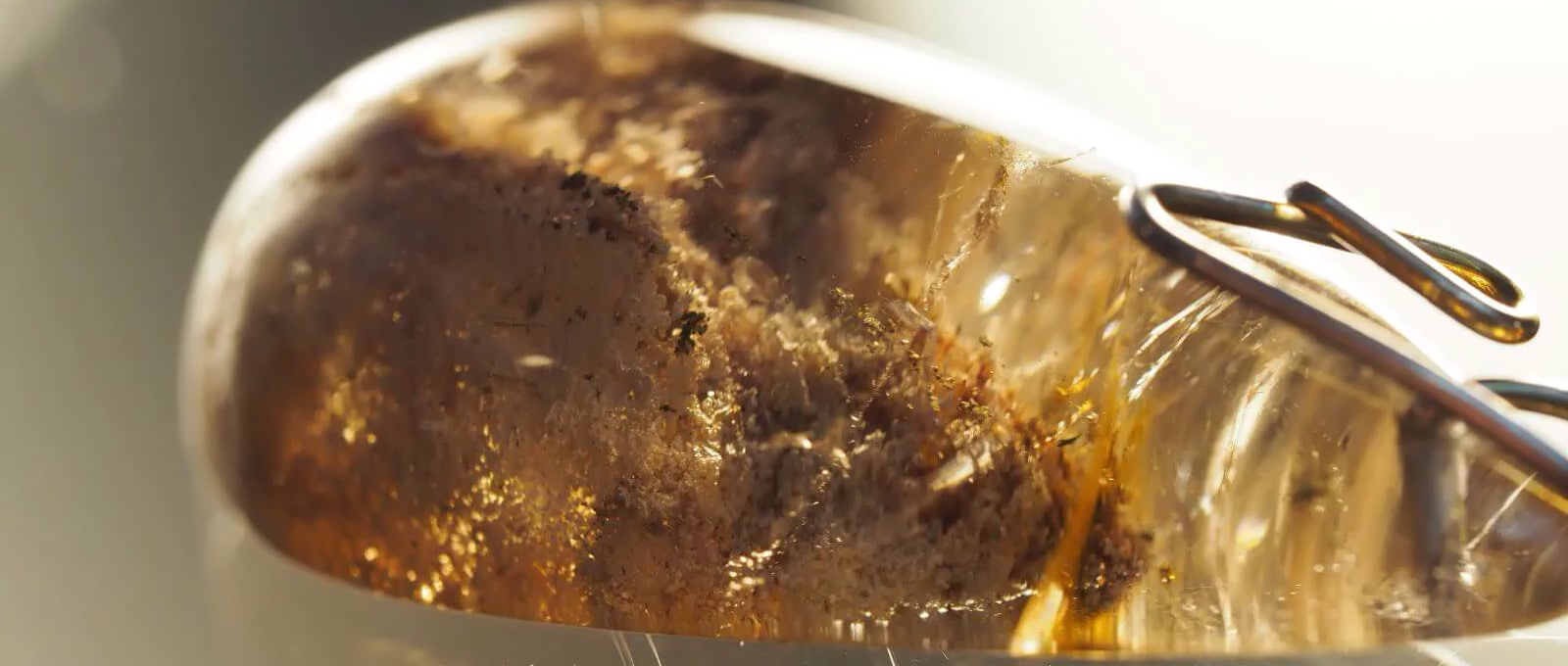Article Highlights
- Scenic Quartz is a mesmerizing type of quartz that boasts unique inclusions, lending it an array of hues and textures.
- The formation of Scenic Quartz involves a complex geological process influenced by a cocktail of minerals.
- This beautiful gemstone hails from the Minas Gerais region in Brazil, a location renowned for its rich deposits of gems and minerals.
- Scenic Quartz’s beauty lies not just in its appearance but also in the geological story it tells.
Isn’t it magical how a simple rock can take you on a journey through time? That’s precisely what you get with Scenic Quartz. Like opening a book, each slice of this incredible gemstone presents a unique tableau, a snapshot of Earth’s history. With its blend of colors and mineral inclusions, it’s a little like peering into an alien landscape.

So, how does this rock come to be? Well, the tale of Scenic Quartz begins in the bubbling, molten heart of our planet. There, under conditions that would obliterate most matter, quartz begins its life.
Initially, quartz forms from a solution of silica-rich water deep within the Earth. Over time, the cooling process causes the silica to form a crystalline structure. Sounds straightforward, right? But wait, the story’s just beginning.
Scenic Quartz isn’t your everyday quartz crystal; it’s quartz with a twist! That’s where the cocktail of inclusions comes into play. Imagine, if you will, our forming quartz crystal. As it begins to solidify from its silicate bath, other minerals present in the surrounding environment like Chlorite, Feldspar, Iron, and trace minerals begin to permeate the crystal.
In this geological tango, the other minerals become captured within the quartz, as if frozen in time. This process results in the stunning and diverse internal landscapes that Scenic Quartz is famous for.

Now, where does this fascinating process take place? Welcome to the Minas Gerais region of Brazil, a treasure chest in the world of gemstones and minerals. This region, blessed with an abundance of precious and semi-precious stones, is the only known location where Scenic Quartz can be found. The unique geological conditions and mineral composition of Minas Gerais are what make this stunning stone possible.
Scenic Quartz colors can swing just about any way on the spectrum, depending on the inclusions and how transparent the quartz crystal is. The most common hues you’ll find are mossy green, dusky pink, inky black, earthy brown, or stormy grey. Each piece is a one-of-a-kind miniature world, a slice of the Earth’s biography.
Scenic Quartz Meaning and Symbolism

- Scenic Quartz, with its miniature landscapes, symbolizes the enduring beauty and resilience of nature.
- It’s known as a stone of transformation, embodying strength and adaptability.
Imagine holding a world in the palm of your hand. That’s the feeling you get when you cradle a piece of Scenic Quartz. Each crystal carries within it a mesmerizing landscape, a tiny testament to the enduring beauty and resilience of nature. In this way, Scenic Quartz becomes more than a stone; it’s a symbol, a touchstone that speaks of the raw power and adaptability of our Earth.
There’s something incredibly grounding about Scenic Quartz. Maybe it’s those rich, earthy tones or the intricate webs of inclusions that remind us of roots reaching deep into the soil. This stone whispers of strength, echoing the journey it has taken from a simple mineral bath to the complex beauty it now displays. It’s a tale of transformation that can inspire us to embrace change and trust in our ability to grow.
But the story doesn’t end there. Scenic Quartz, with its blend of different minerals, also speaks of interconnectedness. Just as the various elements combine to create a harmonious whole within the quartz, so too are we part of a larger, intricate web of existence. Each action, each decision, each moment of kindness or courage, contributes to the landscape of our lives and the world around us.
Scenic Quartz Healing Properties

Embracing the Emotional Echoes of Scenic Quartz
- Scenic Quartz is more than just a beautiful gemstone; it’s a catalyst for emotional balance and resilience.
- With its diverse landscapes, it mirrors our emotional complexities, encouraging exploration and understanding.
- This gemstone resonates with the heart, acting as a steady source of emotional strength.
Ever feel like you’re carrying around an emotional storm? Well, imagine having a personal sanctuary, a calm in the chaos. That’s what Scenic Quartz brings to the table, or rather, to the heart. This remarkable stone, with its swirling inclusions and vibrant hues, reflects our inner emotional landscape.
Picture it now: The mossy greens resonating with feelings of growth and renewal, the inky blacks grounding us, providing a sturdy anchor during emotional upheavals. With every peek into this miniature world, we’re encouraged to explore our feelings, to dive deep and seek understanding instead of fear.
Scenic Quartz isn’t just there for the storms, though. It also echoes the tranquil moments, the peaceful, contented times. Those quiet moments of reflection? They’re mirrored in the dusky pinks and soothing greys. As you gaze into the stone, you’re reminded of balance, of the ebb and flow of emotions. It’s a reminder that it’s okay to feel, to weather the storm and bask in the sunshine.
Unveiling the Spiritual Essence of Scenic Quartz
- Scenic Quartz serves as a gateway to spiritual growth and connection.
- The gemstone’s diverse mineral composition symbolizes unity and interconnectedness.
- It encourages mindfulness and a deep appreciation of the universe’s boundless beauty.
You know how sometimes you feel a little lost, a bit disconnected from the world and yourself? That’s where Scenic Quartz steps in, serving as a kind of spiritual GPS. This stone, with its myriad of mineral inclusions, symbolizes the unity of all things, our interconnectedness within the grand tapestry of the universe.
As you cradle this gemstone, you’re not just holding a piece of the Earth; you’re holding a slice of the cosmos. The smoky blacks and fiery browns remind us of the cosmic dust we all hail from. It’s a humbling and empowering realization, a spiritual wake-up call that sparks a deep appreciation of the universe’s boundless beauty.
The Metaphysical Properties of Scenic Quartz

- Scenic Quartz is a unique quartz variety celebrated for its vivid internal ‘landscapes’.
- Its metaphysical properties include grounding, transformation, and the promotion of interconnectedness.
- Scenic Quartz can be used in meditation, chakra healing, and emotional support.
Let’s dive into the captivating world of Scenic Quartz and unravel the secret metaphysical tapestry it weaves.
Imagine holding a universe in your hands. Picture the tranquility of lush valleys, the mystique of hidden caves, and the enchantment of underwater scenes—all of this encapsulated in the palm of your hand. That’s what it feels like to embrace a piece of Scenic Quartz. Its remarkable inclusions create a panorama of scenes, like nature’s artwork frozen in time.
Often referred to as the stone of transformation, Scenic Quartz is believed to possess a potent energy that facilitates personal growth. It’s like a friend who nudges you gently towards self-discovery, helping you uncover parts of yourself you didn’t know existed.

Imagine a tree, standing tall and rooted deeply in the ground, yet reaching for the sky. That’s the kind of grounding and inspiring energy Scenic Quartz brings to the table. It’s not about anchoring you down but more about providing you a solid foundation to explore your heights.
Scenic Quartz also champions the concept of interconnectedness. Picture a vast, intricate web where everything is linked to everything else. This stone reminds us of our place in that cosmic web. It fosters a sense of unity, that we’re all part of something larger—a singular, divine tapestry.
Wondering how to incorporate Scenic Quartz in your life? Meditation is an excellent place to start. Holding this gemstone while meditating can facilitate a deeper connection with your inner self and the universe. It’s like holding a compass that points to your inner North Star, guiding you towards your true self.
For those walking the path of chakra healing, Scenic Quartz is a fantastic ally. With its grounding energy, it’s particularly associated with the root chakra. It’s like a lovingly placed stepping-stone on your chakra healing journey, helping you establish a secure and balanced foundation.
In terms of emotional support, Scenic Quartz stands tall as a beacon of comfort. Think of it as a friend with a knack for listening, absorbing your emotional distress, and inspiring hope and courage.
Scenic Quartz and Chakras: Unlocking the Energy Within
Scenic Quartz is like a key that unlocks the energy centers within us, known as chakras. Let’s explore its connection to the Crown Chakra (Sahasrara) and the Heart Chakra (Anahata).
Crown Chakra (Sahasrara): The Crown Chakra is the gateway to our spiritual connection and higher consciousness. It’s located at the top of the head, and it represents our connection to the divine, wisdom, and enlightenment. Scenic Quartz resonates with the energy of the Crown Chakra, helping to open and activate it. When using Scenic Quartz in Crown Chakra healing practices, it can facilitate a deeper connection to our higher selves, expanding our awareness, and promoting spiritual growth.
Heart Chakra (Anahata): The Heart Chakra is the center of love, compassion, and emotional well-being. Located at the center of the chest, it governs our ability to give and receive love, cultivate forgiveness, and foster harmony within ourselves and with others. Scenic Quartz’s energy gently resonates with the Heart Chakra, offering support and balance. It can assist in releasing emotional blockages, healing past wounds, and promoting a sense of compassion and unconditional love.
When working with Scenic Quartz and the chakras, it’s beneficial to place the stone on or near the corresponding chakra during meditation or energy healing practices. Visualize the vibrant energy of the stone flowing into the chakra, bringing alignment, healing, and balance to the energy center. Allow the unique ‘landscapes’ within Scenic Quartz to inspire and guide you on your journey of self-discovery and spiritual connection.
Scenic Quartz Zodiac Connection: Gemini and Pisces
Scenic Quartz’s metaphysical energy extends to its connection with zodiac signs, offering unique qualities and support to individuals born under specific signs. Let’s explore its connection to Gemini and Pisces.
Gemini: Gemini, the sign of the Twins, is known for its curious and adaptable nature. Scenic Quartz’s transformative energy resonates well with Gemini’s innate ability to embrace change and explore new experiences. It can support Gemini individuals in their journey of self-discovery, helping them navigate transitions and fostering a deeper understanding of their interconnectedness with the world.
Pisces: Pisces, the compassionate and intuitive water sign, often seeks harmony and spiritual connection. Scenic Quartz’s ethereal landscapes align beautifully with Pisces’ imaginative and empathetic nature. It can enhance Pisces’ intuitive abilities, provide emotional support during times of transformation, and assist in maintaining a balanced and loving energy.
Whether you’re a Gemini seeking inspiration or a Pisces nurturing your spiritual path, Scenic Quartz can be a valuable companion. Its metaphysical properties can amplify your strengths, support personal growth, and deepen your connection to the mystical aspects of life.
Scenic Quartz vs Phantom Quartz
- Scenic Quartz and Phantom Quartz share a bond of inclusions, but their stories diverge with the variety of those inclusions.
- These two quartz variations originate from different parts of the world, adding to their unique appeal.
When it comes to enchanting inclusions, both Scenic Quartz and Phantom Quartz truly stand out. They are the epitome of geologic storytelling, but each one tells its tale a bit differently.
Scenic Quartz, with its vibrant, ever-changing internal landscapes, draws you in. Its colors vary widely depending on the mineral inclusions, offering shades from mossy green to dusky pink or stormy grey. Unique to the Minas Gerais region in Brazil, it carries a piece of this mineral-rich land within each stone.
Phantom Quartz, on the other hand, shows off internal ‘phantoms’ – ghost-like shapes within the crystal caused by pauses in the stone’s growth. These can appear in various colors but are often a smoky or amethyst hue. Unlike Scenic Quartz, Phantom Quartz can be found worldwide, making it a more accessible gem.
In terms of uses, both are coveted by collectors and healers alike. While Scenic Quartz is revered for its representation of transformation and interconnectedness, Phantom Quartz is known as a stone of transition, aiding in personal growth.
Price-wise, Scenic Quartz is somewhat more valuable due to its limited locality. Expect to find pieces ranging from $50 to several hundred dollars. Phantom Quartz, being more common, ranges from $10 to $100.
Scenic Quartz vs Moss Agate
- Both Scenic Quartz and Moss Agate capture the essence of nature within their structures.
- Despite their similar appearances, these two gemstones have different mineral compositions and origins.
Peering into a piece of Scenic Quartz or Moss Agate feels like stepping into a verdant forest. Both these gemstones capture nature in a unique and striking way, yet they’re distinct in their composition and origins.
While Scenic Quartz is a type of quartz with various mineral inclusions, Moss Agate is a form of chalcedony with inclusions of green minerals resembling moss. Despite the name, it’s not a true agate as it lacks the concentric banding of that stone.
Scenic Quartz is sourced exclusively from the Minas Gerais region in Brazil, while Moss Agate has a more widespread occurrence with notable deposits in India, Brazil, Uruguay, and the United States.
Their uses overlap in many areas. Both are beloved by collectors for their scenic displays, and crystal enthusiasts value them for their grounding and balancing energies.
In terms of value, Moss Agate is generally more affordable, with prices ranging from $5 to $50 for most pieces. Scenic Quartz, due to its rarity and unique patterns, can cost between $50 to several hundred dollars.
Scenic Quartz vs Rutilated Quartz
- Both Scenic Quartz and Rutilated Quartz gain their visual interest from inclusions, but the nature of those inclusions sets them apart.
- These gemstones share a common element of quartz but offer unique aesthetics and energies.
Both Scenic Quartz and Rutilated Quartz stand as testament to the allure of inclusions, yet each one sings a different melody.
Scenic Quartz, with its cocktail of mineral inclusions, presents a panorama of landscapes within a single crystal, varying from mossy green landscapes to dusky pink sunsets. Rutilated Quartz, on the other hand, is famed for its needle-like inclusions of rutile, a titanium dioxide mineral. These golden or copper-colored threads give Rutilated Quartz a unique, hair-like appearance.
While Scenic Quartz hails from Brazil, Rutilated Quartz is found in many localities, including Brazil, Madagascar, and the United States.
Both stones are valued by gemstone enthusiasts, with Scenic Quartz being celebrated for its symbolism of transformation and unity, and Rutilated Quartz appreciated for its energy amplifying properties.
Price-wise, Rutilated Quartz, depending on the quality of inclusions, ranges from $10 to $200, while Scenic Quartz, owing to its rarity and scenic beauty, may range from $50 to several hundred dollars.
Scenic Quartz vs Lepidolite
- Scenic Quartz and Lepidolite, despite their differences, both exude a sense of calm and peace.
- They are distinct in their composition, colors, and origins but share a connection with their tranquil energy.
Scenic Quartz and Lepidolite might look worlds apart, but they share a peaceful, calming energy that resonates with many people.
Scenic Quartz, as we’ve established, displays a myriad of colors based on its unique inclusions, painting internal scenes that range from mossy greens to fiery browns. On the flip side, Lepidolite, a lithium-rich mica mineral, has a color palette that leans towards soothing purples, pinks, and greys.
While Scenic Quartz calls Brazil home, Lepidolite is more widely found, with deposits in Brazil, the United States, and Madagascar.
Despite their compositional differences, both stones find their place in the realms of gemstone collection and crystal healing. Scenic Quartz is treasured for its grounding energies and representation of transformation, while Lepidolite is sought after for its calming, stress-relieving properties.
When it comes to value, Lepidolite is quite affordable, with prices ranging from $5 to $50. Scenic Quartz, with its unique, scenic display, fetches a higher price, ranging from $50 to several hundred dollars.
Scenic Quartz vs Chlorite Quartz
- Both Scenic Quartz and Chlorite Quartz feature inclusions that lend them unique beauty.
- Their distinct compositions and origins lead to diverse visual and metaphysical properties.
Scenic Quartz and Chlorite Quartz are two splendid examples of how inclusions can elevate the beauty of a quartz crystal.
Scenic Quartz, with its inclusion-rich nature, boasts an array of colors that paint stunning internal scenes. In contrast, Chlorite Quartz is specifically known for its green chlorite inclusions, giving it a verdant, earthy aesthetic that’s reminiscent of lush forest canopies.
Both these quartz varieties have their roots in Brazil. However, Chlorite Quartz can also be found in the Swiss Alps, Madagascar, and Russia.
Their uses overlap in many ways, with gem enthusiasts loving both for their unique visuals and spiritual properties. Scenic Quartz is celebrated for symbolizing transformation and interconnectedness, whereas Chlorite Quartz is believed to be a powerful cleanser and purifier.
When it comes to value, Scenic Quartz generally fetches a higher price due to its unique visual appeal, ranging from $50 to several hundred dollars. Chlorite Quartz, being somewhat more common, ranges between $10 to $150.
Scenic Quartz vs Smoky Quartz
- Scenic Quartz and Smoky Quartz share a link to quartz but differ in their colors and inclusions.
- Their differing origins and properties make them unique gems in their own right.
Scenic Quartz and Smoky Quartz may both be quartz varieties, but they certainly have their own unique flairs.
Scenic Quartz showcases a spectrum of colors based on its diverse mineral inclusions, which offer it an ever-changing internal landscape. Conversely, Smoky Quartz is known for its smoky brown to black color, reminiscent of an earthy autumn evening.
While Scenic Quartz is specific to the Minas Gerais region in Brazil, Smoky Quartz has a more global presence, with deposits found in Brazil, Australia, Madagascar, Switzerland, and the United States.
Both stones find favor among gem collectors and crystal healing enthusiasts. Scenic Quartz, with its representations of transformation and unity, contrasts with Smoky Quartz, which is often used for grounding and balancing energies.
In terms of value, Smoky Quartz is more affordable due to its widespread availability, with prices typically ranging from $5 to $100. On the other hand, Scenic Quartz can command prices from $50 to several hundred dollars, depending on the quality of the inclusions.
Scenic Quartz vs Tourmalinated Quartz
- Scenic Quartz and Tourmalinated Quartz highlight the appeal of inclusions within quartz crystals.
- Despite the shared quartz component, these gemstones diverge in their colors, inclusions, and origins.
Scenic Quartz and Tourmalinated Quartz are truly the gems of geological artistry, showcasing how inclusions can create intricate beauty within quartz crystals.
Scenic Quartz offers a rich variety of colors, thanks to its diverse mineral inclusions that paint unique internal landscapes. Tourmalinated Quartz, on the other hand, is characterized by its needle-like inclusions of black tourmaline, creating a striking contrast against the clear or milky white quartz.
While Scenic Quartz is a Brazilian exclusive, Tourmalinated Quartz can be found in various locations worldwide, including Brazil, Pakistan, and the United States.
In the realms of gemstone collection and crystal healing, both stones have carved a niche for themselves. Scenic Quartz is prized for its representation of transformation and interconnectedness, while Tourmalinated Quartz is appreciated for its protective and balancing properties.
As for value, Tourmalinated Quartz, due to its widespread availability, can range from $5 to $100. In contrast, the more rare and visually unique Scenic Quartz can cost anywhere from $50 to several hundred dollars.
Frequently Asked Questions About Scenic Quartz
What is Scenic Quartz?
Scenic Quartz, also known as Lodolite, is a type of quartz that contains mineral inclusions, creating beautiful, scenic-like patterns within the stone.
Where is Scenic Quartz found?
Scenic Quartz is found exclusively in the Minas Gerais region of Brazil.
What colors can Scenic Quartz be?
The color of Scenic Quartz can vary widely, from mossy green and pink to black, brown, or grey, depending on the types of mineral inclusions.
How is Scenic Quartz formed?
Scenic Quartz is formed over millions of years in the Earth’s crust when quartz crystals grow over various other minerals, encapsulating them and creating unique patterns and ‘scenes’.
Is Scenic Quartz valuable?
Yes, due to its unique patterns and limited locality, Scenic Quartz is considered valuable, with prices ranging from $50 to several hundred dollars.
How to clean Scenic Quartz?
You can clean Scenic Quartz with mild soapy water and a soft cloth or brush. Avoid harsh chemicals and extreme heat.
How can I tell if my Scenic Quartz is real?
Real Scenic Quartz should have a clear to milky quartz base with visible inclusions. A trusted gemologist can help confirm its authenticity.
Can Scenic Quartz be synthetically made?
While it is possible to synthesize quartz, the unique inclusions and patterns in Scenic Quartz would be incredibly difficult to replicate, making most Scenic Quartz on the market natural.
Is Scenic Quartz a birthstone?
No, Scenic Quartz is not traditionally considered a birthstone.
What other names is Scenic Quartz known by?
Scenic Quartz is also known as Lodolite, Inclusion Quartz, Landscape Quartz, and Shamanic Dream Quartz.
| Scenic Quartz Physical Properties | |
|---|---|
| Crystal Structure | Trigonal |
| Mineral Class | Silicate |
| Specific Gravity | 2.65 |
| Formula | SiO2 + various inclusions |
| Hardness | 7 on Mohs scale |
| Transparency | Transparent to Translucent |
| Chemical Composition | Silicon Dioxide with inclusions |
| Locations | Minas Gerais, Brazil |
| Rarity | Rare |
| Can Be Submerged in Water | Yes, but should be dried immediately |
| Sun Safe Crystal | Yes, but prolonged exposure may fade colors |
| Special Care Instructions | Clean gently with soapy water; avoid harsh chemicals |
| Price/Carat | Ranges from $5 to $50 per carat, depending on quality and inclusions |
| Scenic Quartz Metaphysical Properties | |
|---|---|
| Chakras | Crown Chakra (Sahasrara), Heart Chakra (Anahata) |
| Zodiac Signs | Gemini, Pisces |
| Planets | Not associated with specific planets |
| Numerical Vibration | Not associated with specific numbers |
| Elements | Earth, Water |
| Symbolism | Transformation, interconnectedness |
| Birthstones | Not a traditional birthstone |
| Affirmations | “I embrace transformation and growth.” “I am connected to the divine and the world around me.” |
| Emotional Conditions | Grounding, emotional support, compassion, spiritual growth |
| Spiritual Purposes | Opening and activating the Crown Chakra, fostering love and harmony in the Heart Chakra, deepening spiritual connection |
| Crystal Combinations | Amethyst, Clear Quartz, Rose Quartz, Black Tourmaline, Selenite |

